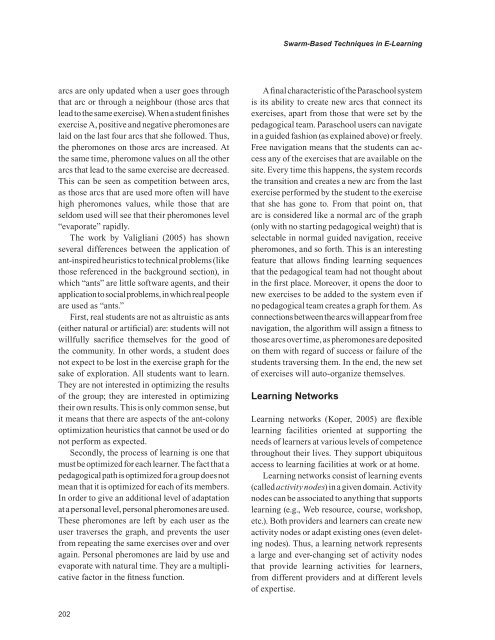Advances in E-learning-Experiences and Methodologies
You also want an ePaper? Increase the reach of your titles
YUMPU automatically turns print PDFs into web optimized ePapers that Google loves.
Swarm-Based Techniques <strong>in</strong> E-Learn<strong>in</strong>g<br />
arcs are only updated when a user goes through<br />
that arc or through a neighbour (those arcs that<br />
lead to the same exercise). When a student f<strong>in</strong>ishes<br />
exercise A, positive <strong>and</strong> negative pheromones are<br />
laid on the last four arcs that she followed. Thus,<br />
the pheromones on those arcs are <strong>in</strong>creased. At<br />
the same time, pheromone values on all the other<br />
arcs that lead to the same exercise are decreased.<br />
This can be seen as competition between arcs,<br />
as those arcs that are used more often will have<br />
high pheromones values, while those that are<br />
seldom used will see that their pheromones level<br />
“evaporate” rapidly.<br />
The work by Valigliani (2005) has shown<br />
several differences between the application of<br />
ant-<strong>in</strong>spired heuristics to technical problems (like<br />
those referenced <strong>in</strong> the background section), <strong>in</strong><br />
which “ants” are little software agents, <strong>and</strong> their<br />
application to social problems, <strong>in</strong> which real people<br />
are used as “ants.”<br />
First, real students are not as altruistic as ants<br />
(either natural or artificial) are: students will not<br />
willfully sacrifice themselves for the good of<br />
the community. In other words, a student does<br />
not expect to be lost <strong>in</strong> the exercise graph for the<br />
sake of exploration. All students want to learn.<br />
They are not <strong>in</strong>terested <strong>in</strong> optimiz<strong>in</strong>g the results<br />
of the group; they are <strong>in</strong>terested <strong>in</strong> optimiz<strong>in</strong>g<br />
their own results. This is only common sense, but<br />
it means that there are aspects of the ant-colony<br />
optimization heuristics that cannot be used or do<br />
not perform as expected.<br />
Secondly, the process of learn<strong>in</strong>g is one that<br />
must be optimized for each learner. The fact that a<br />
pedagogical path is optimized for a group does not<br />
mean that it is optimized for each of its members.<br />
In order to give an additional level of adaptation<br />
at a personal level, personal pheromones are used.<br />
These pheromones are left by each user as the<br />
user traverses the graph, <strong>and</strong> prevents the user<br />
from repeat<strong>in</strong>g the same exercises over <strong>and</strong> over<br />
aga<strong>in</strong>. Personal pheromones are laid by use <strong>and</strong><br />
evaporate with natural time. They are a multiplicative<br />
factor <strong>in</strong> the fitness function.<br />
A f<strong>in</strong>al characteristic of the Paraschool system<br />
is its ability to create new arcs that connect its<br />
exercises, apart from those that were set by the<br />
pedagogical team. Paraschool users can navigate<br />
<strong>in</strong> a guided fashion (as expla<strong>in</strong>ed above) or freely.<br />
Free navigation means that the students can access<br />
any of the exercises that are available on the<br />
site. Every time this happens, the system records<br />
the transition <strong>and</strong> creates a new arc from the last<br />
exercise performed by the student to the exercise<br />
that she has gone to. From that po<strong>in</strong>t on, that<br />
arc is considered like a normal arc of the graph<br />
(only with no start<strong>in</strong>g pedagogical weight) that is<br />
selectable <strong>in</strong> normal guided navigation, receive<br />
pheromones, <strong>and</strong> so forth. This is an <strong>in</strong>terest<strong>in</strong>g<br />
feature that allows f<strong>in</strong>d<strong>in</strong>g learn<strong>in</strong>g sequences<br />
that the pedagogical team had not thought about<br />
<strong>in</strong> the first place. Moreover, it opens the door to<br />
new exercises to be added to the system even if<br />
no pedagogical team creates a graph for them. As<br />
connections between the arcs will appear from free<br />
navigation, the algorithm will assign a fitness to<br />
those arcs over time, as pheromones are deposited<br />
on them with regard of success or failure of the<br />
students travers<strong>in</strong>g them. In the end, the new set<br />
of exercises will auto-organize themselves.<br />
Learn<strong>in</strong>g networks<br />
Learn<strong>in</strong>g networks (Koper, 2005) are flexible<br />
learn<strong>in</strong>g facilities oriented at support<strong>in</strong>g the<br />
needs of learners at various levels of competence<br />
throughout their lives. They support ubiquitous<br />
access to learn<strong>in</strong>g facilities at work or at home.<br />
Learn<strong>in</strong>g networks consist of learn<strong>in</strong>g events<br />
(called activity nodes) <strong>in</strong> a given doma<strong>in</strong>. Activity<br />
nodes can be associated to anyth<strong>in</strong>g that supports<br />
learn<strong>in</strong>g (e.g., Web resource, course, workshop,<br />
etc.). Both providers <strong>and</strong> learners can create new<br />
activity nodes or adapt exist<strong>in</strong>g ones (even delet<strong>in</strong>g<br />
nodes). Thus, a learn<strong>in</strong>g network represents<br />
a large <strong>and</strong> ever-chang<strong>in</strong>g set of activity nodes<br />
that provide learn<strong>in</strong>g activities for learners,<br />
from different providers <strong>and</strong> at different levels<br />
of expertise.<br />
0


